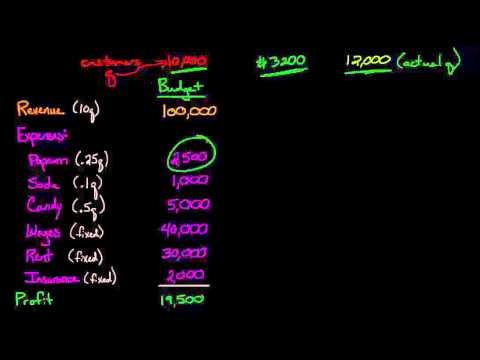7.11: Flexible Budgets
- Page ID
- 26089
\( \newcommand{\vecs}[1]{\overset { \scriptstyle \rightharpoonup} {\mathbf{#1}} } \)
\( \newcommand{\vecd}[1]{\overset{-\!-\!\rightharpoonup}{\vphantom{a}\smash {#1}}} \)
\( \newcommand{\dsum}{\displaystyle\sum\limits} \)
\( \newcommand{\dint}{\displaystyle\int\limits} \)
\( \newcommand{\dlim}{\displaystyle\lim\limits} \)
\( \newcommand{\id}{\mathrm{id}}\) \( \newcommand{\Span}{\mathrm{span}}\)
( \newcommand{\kernel}{\mathrm{null}\,}\) \( \newcommand{\range}{\mathrm{range}\,}\)
\( \newcommand{\RealPart}{\mathrm{Re}}\) \( \newcommand{\ImaginaryPart}{\mathrm{Im}}\)
\( \newcommand{\Argument}{\mathrm{Arg}}\) \( \newcommand{\norm}[1]{\| #1 \|}\)
\( \newcommand{\inner}[2]{\langle #1, #2 \rangle}\)
\( \newcommand{\Span}{\mathrm{span}}\)
\( \newcommand{\id}{\mathrm{id}}\)
\( \newcommand{\Span}{\mathrm{span}}\)
\( \newcommand{\kernel}{\mathrm{null}\,}\)
\( \newcommand{\range}{\mathrm{range}\,}\)
\( \newcommand{\RealPart}{\mathrm{Re}}\)
\( \newcommand{\ImaginaryPart}{\mathrm{Im}}\)
\( \newcommand{\Argument}{\mathrm{Arg}}\)
\( \newcommand{\norm}[1]{\| #1 \|}\)
\( \newcommand{\inner}[2]{\langle #1, #2 \rangle}\)
\( \newcommand{\Span}{\mathrm{span}}\) \( \newcommand{\AA}{\unicode[.8,0]{x212B}}\)
\( \newcommand{\vectorA}[1]{\vec{#1}} % arrow\)
\( \newcommand{\vectorAt}[1]{\vec{\text{#1}}} % arrow\)
\( \newcommand{\vectorB}[1]{\overset { \scriptstyle \rightharpoonup} {\mathbf{#1}} } \)
\( \newcommand{\vectorC}[1]{\textbf{#1}} \)
\( \newcommand{\vectorD}[1]{\overrightarrow{#1}} \)
\( \newcommand{\vectorDt}[1]{\overrightarrow{\text{#1}}} \)
\( \newcommand{\vectE}[1]{\overset{-\!-\!\rightharpoonup}{\vphantom{a}\smash{\mathbf {#1}}}} \)
\( \newcommand{\vecs}[1]{\overset { \scriptstyle \rightharpoonup} {\mathbf{#1}} } \)
\( \newcommand{\vecd}[1]{\overset{-\!-\!\rightharpoonup}{\vphantom{a}\smash {#1}}} \)
\(\newcommand{\avec}{\mathbf a}\) \(\newcommand{\bvec}{\mathbf b}\) \(\newcommand{\cvec}{\mathbf c}\) \(\newcommand{\dvec}{\mathbf d}\) \(\newcommand{\dtil}{\widetilde{\mathbf d}}\) \(\newcommand{\evec}{\mathbf e}\) \(\newcommand{\fvec}{\mathbf f}\) \(\newcommand{\nvec}{\mathbf n}\) \(\newcommand{\pvec}{\mathbf p}\) \(\newcommand{\qvec}{\mathbf q}\) \(\newcommand{\svec}{\mathbf s}\) \(\newcommand{\tvec}{\mathbf t}\) \(\newcommand{\uvec}{\mathbf u}\) \(\newcommand{\vvec}{\mathbf v}\) \(\newcommand{\wvec}{\mathbf w}\) \(\newcommand{\xvec}{\mathbf x}\) \(\newcommand{\yvec}{\mathbf y}\) \(\newcommand{\zvec}{\mathbf z}\) \(\newcommand{\rvec}{\mathbf r}\) \(\newcommand{\mvec}{\mathbf m}\) \(\newcommand{\zerovec}{\mathbf 0}\) \(\newcommand{\onevec}{\mathbf 1}\) \(\newcommand{\real}{\mathbb R}\) \(\newcommand{\twovec}[2]{\left[\begin{array}{r}#1 \\ #2 \end{array}\right]}\) \(\newcommand{\ctwovec}[2]{\left[\begin{array}{c}#1 \\ #2 \end{array}\right]}\) \(\newcommand{\threevec}[3]{\left[\begin{array}{r}#1 \\ #2 \\ #3 \end{array}\right]}\) \(\newcommand{\cthreevec}[3]{\left[\begin{array}{c}#1 \\ #2 \\ #3 \end{array}\right]}\) \(\newcommand{\fourvec}[4]{\left[\begin{array}{r}#1 \\ #2 \\ #3 \\ #4 \end{array}\right]}\) \(\newcommand{\cfourvec}[4]{\left[\begin{array}{c}#1 \\ #2 \\ #3 \\ #4 \end{array}\right]}\) \(\newcommand{\fivevec}[5]{\left[\begin{array}{r}#1 \\ #2 \\ #3 \\ #4 \\ #5 \\ \end{array}\right]}\) \(\newcommand{\cfivevec}[5]{\left[\begin{array}{c}#1 \\ #2 \\ #3 \\ #4 \\ #5 \\ \end{array}\right]}\) \(\newcommand{\mattwo}[4]{\left[\begin{array}{rr}#1 \amp #2 \\ #3 \amp #4 \\ \end{array}\right]}\) \(\newcommand{\laspan}[1]{\text{Span}\{#1\}}\) \(\newcommand{\bcal}{\cal B}\) \(\newcommand{\ccal}{\cal C}\) \(\newcommand{\scal}{\cal S}\) \(\newcommand{\wcal}{\cal W}\) \(\newcommand{\ecal}{\cal E}\) \(\newcommand{\coords}[2]{\left\{#1\right\}_{#2}}\) \(\newcommand{\gray}[1]{\color{gray}{#1}}\) \(\newcommand{\lgray}[1]{\color{lightgray}{#1}}\) \(\newcommand{\rank}{\operatorname{rank}}\) \(\newcommand{\row}{\text{Row}}\) \(\newcommand{\col}{\text{Col}}\) \(\renewcommand{\row}{\text{Row}}\) \(\newcommand{\nul}{\text{Nul}}\) \(\newcommand{\var}{\text{Var}}\) \(\newcommand{\corr}{\text{corr}}\) \(\newcommand{\len}[1]{\left|#1\right|}\) \(\newcommand{\bbar}{\overline{\bvec}}\) \(\newcommand{\bhat}{\widehat{\bvec}}\) \(\newcommand{\bperp}{\bvec^\perp}\) \(\newcommand{\xhat}{\widehat{\xvec}}\) \(\newcommand{\vhat}{\widehat{\vvec}}\) \(\newcommand{\uhat}{\widehat{\uvec}}\) \(\newcommand{\what}{\widehat{\wvec}}\) \(\newcommand{\Sighat}{\widehat{\Sigma}}\) \(\newcommand{\lt}{<}\) \(\newcommand{\gt}{>}\) \(\newcommand{\amp}{&}\) \(\definecolor{fillinmathshade}{gray}{0.9}\)Early in the chapter, you learned that a budget should be adjusted for changes in assumptions or variations in the level of operations. Managers use a technique known as flexible budgeting to deal with budgetary adjustments. A flexible operating budget is a special kind of budget that provides detailed information about budgeted expenses (and revenues) at various levels of output.
Leed Company’s manufacturing overhead cost budget at 70% capacity is shown below. Leed can produce 25,000 units in a 3 month period or a quarter, which represents 100% of capacity.
| Leed Company | |
| Manufacturing Overhead Cost | |
| 3-month Budget | |
| Supplies | $1,400 |
| Power | 7,000 |
| Insurance | 4,200 |
| Maintenance | 4,900 |
| Depreciation | 18,000 |
| Supervision | 57,000 |
| Total Overhead Costs | $92,500 |
| Units Produced (70% capacity) | 17,500 |
To keep the example simple, we assume that the first four costs are strictly variable and we will calculate a budget per unit for these costs. On the other hand, the last two costs, depreciation and supervision, are fixed costs and are assumed to be constant over the entire relevant range of activity meaning they do not change based on volume. The table below shows the calculations for units produced at 70% capacity and calculates the variable cost per unit for all variable costs.
| Variable | Fixed | Calculation | ||
| Units produced | 17,500 units | (25,00 units x 70% capacity) | ||
| Supplies | $1,400 | $0.08 | ($1,400 / 17,500 units) | |
| Power | 7,000 | $0.40 | ($7,000 / 17,500 units) | |
| Insurance | 4,200 | $0.24 | ($4,200 / 17,500 units) | |
| Maintenance | 4,900 | $0.28 | ($4,900 / 17,500 units) | |
| Depreciation | 18,000 | $18,000 | No calculation – fixed cost | |
| Supervision | 57,000 | $57,000 | No calculation – fixed cost |
Now that we know the variable costs per unit. we can calculate the flexible budget for any level of activity using these figures. Leed Company prepares a flexible budget for 70%, 80%, 90% and 100% capacity. Notice how the variable costs change with volume but the fixed costs remain the same.
| Leed Company | ||||||
| Flexible Budget for Mfg Overhead | ||||||
| 70% capacity | 80% capacity | 90% capacity | 100%
capacity |
|||
| Volume (in units) | (25,000 units x capacity %) | 17,500 | 20,000 | 22,250 | 25,000 | |
| Variable |
Fixed |
|||||
| Supplies | $0.08 | $1,400 | $1,600 | $1,780 | $2,000 | |
| (17,500 units x $0.08) | (20,000 units x $0.08) | (22,250 units x $0.08) | (25,000 units x $0.08) | |||
| Power | $0.40 | 7,000 | 8,000 | 8,900 | 10,000 | |
| (17,500 units x $0.40) | (20,000 units x $0.40) | (22,250 units x $0.40) | (25,000 units x $0.40) | |||
| Insurance | $0.24 | 4,200 | 4,800 | 5,340 | 6,000 | |
| (17,500 units x $0.24) | (20,000 units x $0.24) | (22,250 units x $0.24) | (25,000 units x $0.24) | |||
| Maintenance | $0.28 | 4,900 | 5,600 | 6,230 | 7,000 | |
| (17,500 units x $0.24) | (20,000 units x $0.24) | (22,250 units x $0.24) | (25,000 units x $0.24) | |||
| Depreciation | $18,000 | 18,000 | 18,000 | 18,000 | 18,000 | |
| Supervision | $57,000 | 57,000 | 57,000 | 57,000 | 57,000 | |
| Total Mfg Overhead | $92,500 | $95,000 | $97,250 | $100,000 | ||
A flexible budget can be prepared for any level of activity. The advantage to a flexible budget is we can create a budget based on the ACTUAL level of production to give us a clearer picture of our results by comparing the flexible budget to actual results. This analysis would compare the actual level of activity so volume variances are not a factor and management can focus on the cost variances only. We will discuss this analysis next in the performance report.
- Flexible Budgeting. Authored by: Education Unlocked. Located at: youtu.be/JHVaey2WdPE. License: All Rights Reserved. License Terms: Standard YouTube License


